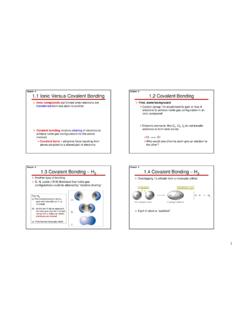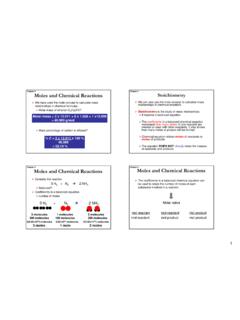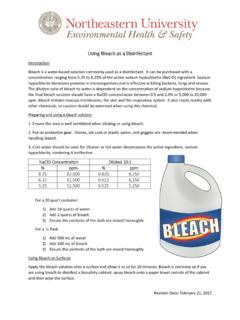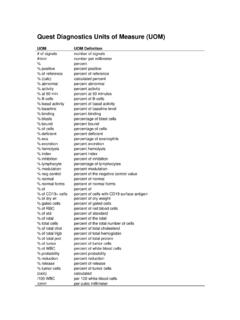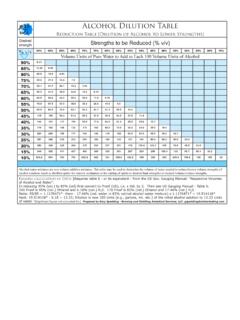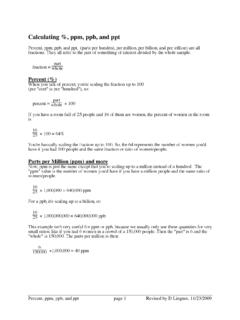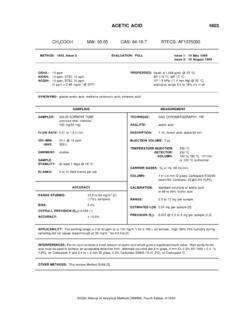Transcription of Chapter 3 Molar Mass Calculation of Molar Masses
1 1 Molar Mass Molar mass = Mass in grams of one mole of any element, numerically equal to its atomic weight Molar mass of molecules can be determined from the chemical formula and Molar Masses of elements Each H2O molecule contains 2 H atoms and 1 O atom Each moleof H2O molecules contains 2 moles of H and 1 mole of O One moleof O atoms corresponds to g Two molesof H atoms corresponds to 2 x g Sum = Molar mass= g H2O per moleChapter 3 Calculation of Molar Masses Calculate the Molar mass of the following Magnesium nitrate, Mg(NO3)21 Mg = N = 2x = O = 6 x = mass of Mg(NO3)2= g Calcium carbonate, CaCO31 Ca = C = O = 3 x mass of CaCO3= g Iron(II) sulfate, FeSO4 Molar mass of FeSO4= gChapter 3 Solutions Solution: a homogenous mixture in which the components are evenly distributed in each other Solute: the component of a solution that is dissolved in another substance Solvent: the medium in which a solute dissolved to form a solution Aqueous: any solution in which water is the solventChapter 5 The properties and behavior of solutions often depend not only on the type of solutebut also on the concentrationof the solute.
2 Concentration:the amount of solute dissolved in a given quantity of solvent or solution many different concentration units (%, ppm, g/L, etc) often expressed as MolaritySolutionsChapter 52 Solution Concentrations Molarity= moles of solute per liter of solution Designated by a capital M (mol/L) M HCl moles of HCl per liter of solution. M HCl moles of HCl per liter of 5 Molarity can be used as a conversion factor. The definition of molarity contains 3 quantities:Molarity= moles of solutevolume of solution in liters If you know two of these quantities, you can find the ConcentrationsChapter 5 Determine the molarity of each solution L of solution containing mol of soluteMolarity= moles of solutevolume of solution in liters 225 mL of solution containing mole of solute 100.
3 ML of solution containing g of NaClStrategy:Solution ConcentrationsChapter 5g mol molarityMolarity= moles of solutevolume of solution in litersGiven: L of HClFind:mol HClUse molarity as a conversion factorMol HCl = L soln x mol HCl1 L of soln= mol HClSolution PreparationChapter 5 Example: How many moles of HCl are present in L of M HCl?3 Example: What volume of a M NaOH solution is needed to provide mol of NaOH? mol M NaOHFind:vol solnUse M as a conversion factorVol soln = mol NaOH x 1 L mol NaOH= L solutionSolution PreparationChapter 5 Solution Preparation Solutions of exact concentrations are prepared by dissolving the proper amount of solute in the correct amount of solvent to give the desired final volume Determine the proper amount of solute How is the final volume measured accurately?
4 Chapter 5 Example: How many grams of CuSO4are needed to prepare mL of M CuSO4?Given: mL solution M CuSO4 Find:g CuSO4 Conversion factors:Molarity, Molar massStrategy:mL L mol gramsSolution PreparationChapter 5g CuSO4 = mL solnx 1 mol1000 mL1 L solnx g CuSO41 mol = g CuSO4 Solution PreparationChapter 5 Given: mL solution, M CuSO4 Find: g CuSO4 Strategy:mL L mol grams4 Solution Preparation Describe how to prepare the following: 500. mL of M FeSO4 Strategy:mL L mol gramsg FeSO4 = ml x 1 L x mol x g1000 ml 1 L 1 mol= g 100. mL of M glucose 250. mL of M NaClChapter 5 Steps involved in preparing solutions from pure solidsSolution PreparationChapter 5 Steps involved in preparing solutions from pure solids Calculate the amount of solid required Weigh out the solid Place in an appropriate volumetric flask Fill flask about half full with water and mix.
5 Fill to the mark with water and invert to PreparationChapter 5 Solution Preparation Solutions of exact concentrations can also be prepared by diluting a more concentrated solution of the solute to the desiredconcentrationChapter 55 Many laboratory chemicals such as acids are purchased as concentrated solutions (stock solutions). 12 M HCl 12 M H2SO4 More dilute solutions are prepared by taking a certain quantity of the stock solution and diluting it with PreparationChapter 5 A given volume of a stock solution contains a specific number of moles of solute. 25 mL of M HCl contains mol HCl(How do you know this???) If 25 mL of M HCl is diluted with 25 mLof water, the number of moles of HCl present does not change. Still contains mol HCl Solution PreparationChapter 5 Moles solute moles solutebefore dilution after dilution Although the number of moles of solute does not change, the volume of solution does change.
6 The concentration of the solution will change since Molarity = mol solutevolume solutionSolution PreparationChapter 5= When a solution is diluted, the concentration of the new solution can be found using:Mc Vc= moles= Md VdWhere, Mc= concentration of concentrated solution (mol/L)Vc = volume of concentrated solutionMd= concentration of diluted solution (mol/L)Vd= volume of diluted solutionSolution PreparationChapter 56 Example: What is the concentration of a solution prepared by diluting mL of M HCl to a total volume of mL?Given: Vc= mLMc= MVd= mLFind:MdMc x Vc= Mdx VdSolution PreparationChapter 5Mc Vc= Md M x mL = Mdx mLMd= mL= mLNote: Vcand Vddo not have to be in liters, but they must be in the same PreparationChapter 5 Solution Preparation Describe how to prepare 500.
7 ML of M NaOH solution using a M NaOH : Mc= MMd= MVd= mLFind: VcMc Vc= Md Vd What volume of M NaCl should be diluted to give 250. mL of a M solution? Chapter 5 Concentrations of Acids The pH scaleChapter 5pH = -log [H+]pH of vinegar = -log ( x 10-3M) = - ( ) = of pure water = -log ( x 10-7M) = - ( ) = of blood = -log ( x 10-8M) = - ( ) = of ammonia = -log ( x 10-11M) = - ( ) = substance, pH< 7 Basic substance, pH >7neutral, pH = 7 Lower the concentration of H+, higher the pH7 On serial dilution of acid solution, the pH increases because the concentration of H+ions decreases with dilution The H+concentration of a solution of known pH can be calculated using the following M M HCl3[H+] = 10-pHConcentrations of AcidsChapter 5 Concentrations of AcidsChapter 5 Calculate pH of M HCl solution.
8 Calculate the concentration of H+ion in a solution of pH Preparation Review If you dissolve g of potassium chloride in L, what is the final Molar concentration? How many grams of sodium sulfate are contained in (dissolved in) mL of M solution? Chapter 5 Solution Preparation Review What volume of M sulfuric acid should be diluted to produce L of M solution? What s the pH of the final solution? Chapter 58 Solution Preparation Review What volume of M potassium permanganate contains 322 g of the solute? Chapter 5 Conversion FactorsNumber of particlesMolesMassAvogadro s x 1023 MolarmassChapter 3 Molar Conversions Determine the following: The moles of potassium atoms in a g sample The mass of Mg in a mole sampleChapter 3 Moles x = gramsgrams1 molGrams x = moles1 molgramsMolar Conversions Determine the following: The moles of FeCl3in a g sample The mass of MgCl2in a mole sampleChapter 39 Molar Conversions glucose = C6H12O6 ( Molar mass = g) How many moles of glucose are contained in g of C6H12O6?
9 How many moles of oxygen are contained in g of C6H12O6? How many grams of H are contained in g of C6H12O6? Chapter 3 Grams x = moles1 molgrams The relative number of moles of each element in a substance can be used as a conversion factor called the Molar ratio. Molar ratio = moles element Amole of substance Molar ratio =moles element Amoles element B orMolar RatiosChapter 3 H2O: Molar Ratio = 2 moles of Hmole H2O Molar Ratio = 1 mole Omole H2O Molar Ratio = 2 moles Hmole OMolar RatiosChapter 3 C6H12O6: Molar Ratio = 6 moles of Cmole C6H12O6 Molar Ratio =12 moles Hmole C6H12O6 Molar Ratio =6 moles Omole C6H12O6 Molar Ratio =6 moles C = 1 mol C12 moles H 2 moles HMolar RatiosChapter 310 Molar ratios can be used to determine the number of moles of a particular element in a given substance.
10 How many moles of oxygen are contained in g of C6H12O6?MolesOMolesC6H12O6 Molar RatioMolar ConversionsChapter 3 Molar ConversionsChapter 3 Given: g of C6H12O6 Find: Moles of Ograms of glucose moles of glucose moles of oxygenMoles of O = g of C6H12O6x 1mol C6H12O6 x 6 mol OMolar massMolar ratiomol g= mol O Strategy: Once the number of moles of a substance present is known, we can use: Molar mass to find the number of grams Avogadro s number to find the number of atoms, ions, or moleculesMoles BGrams BAtoms BMolarmassNAMoles AMolarRatioMolar ConversionsChapter 3 How many grams of H are contained in g of C6H12O6?Moles HGrams HAtoms HMolarmassNAMoles C6H12O6 MolarRatioMolar ConversionsChapter 311 Given: g of C6H12O6 Find: gram Hg H = g C6H12O6x 1mol C6H12O6 x 12 mol H x g= Hmol HMolar ConversionsChapter 3# H = g C6H12O6x 1mol C6H12O6 x 12 mol H x x 1023atomsmol gmol H= x 1023atoms of HMolar Conversions How many moles of nitrogen are contained in g of C6H5NO3?
